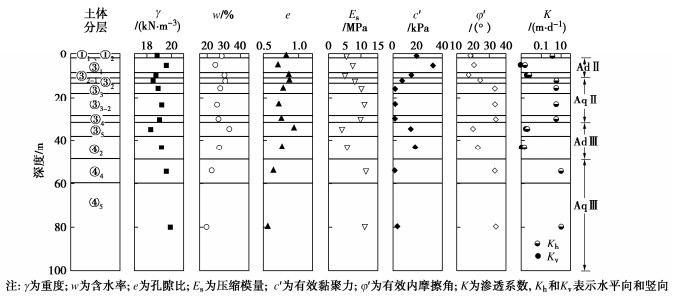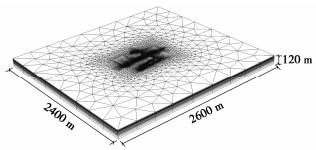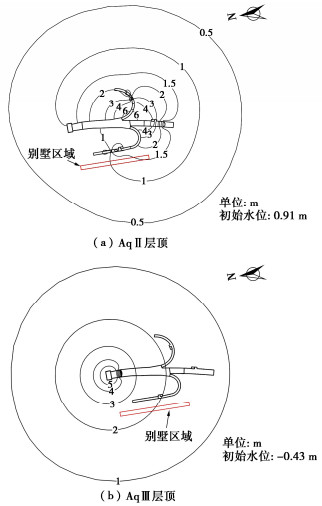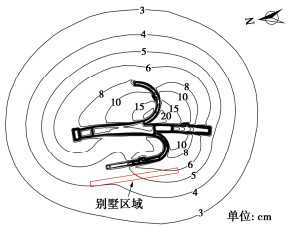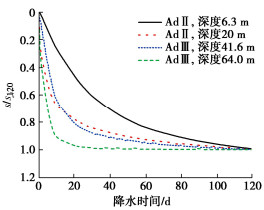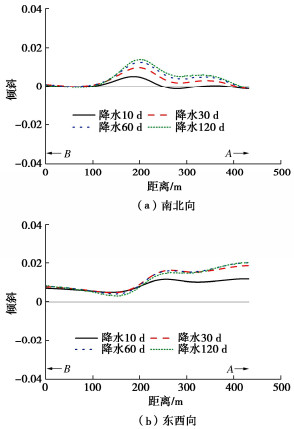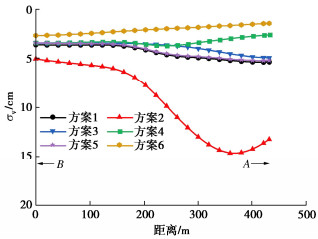Environmental effects of confined aquifer dewatering for cut and cover tunnels in floodplain areas of Yangtze River
-
摘要: 长江漫滩区地质条件复杂,承压水位高,明挖隧道基坑降承压水可能会引起一定程度的沉降,进而引起建构筑物破坏及生命财产损失。针对该问题,以江阴靖江长江隧道江南标段明挖隧道基坑工程降水施工为例,建立了降承压水有限元模型,分析了邻近敏感别墅区的水位降深、沉降及倾斜特性,并研究了不同止水帷幕设计对沉降的影响。结果表明,降承压水引起的地表沉降稳定速度较慢,降水10,30,60,120 d时,别墅区最大沉降为2.5,4.3,5.4,6.1 cm。倾斜稳定相对较快,最大倾斜约0.0002,满足规范要求。本工程止水帷幕设计变更方案可使别墅区最大沉降降低63.5%。在基坑主线将第二承压含水层隔断可最高效地进一步降低别墅区最大沉降。Abstract: Confined aquifer dewatering for cut and cover tunnels in the floodplain areas of Yangtze River characterized by complicated geological condition and high confined water level may result in considerable ground settlements, which may potentially cause structural damages and losses of life and property. Aiming at this issue, the finite element model for the confined aquifer dewatering is developed based on the southern part of a cut and cover tunnel of the Jiangyin-Jingjiang Yangtze River Tunnel Project, and the characteristics of drawdown, ground settlement and incline of a sensitive villa district are analyzed. The effects of various designs of curtain on the ground settlements are also studied. It is found that the settlements induced by the confined aquifer dewatering cannot converge fast. The maximum settlements of the villa district for 10, 30, 60 and 120 days of dewatering are 2.5, 4.3, 5.4 and 6.1 cm, respectively. The inclines converge faster with the maximum value of 0.0002, which meets the requirements of China's standard. The altered curtain design can reduce the maximum settlement in the villa district by 63.5%. Cutting off the second confined aquifer in the mainline can further reduce the maximum settlement with the highest efficiency.
-
Keywords:
- cut and cover tunnel /
- confined water /
- dewatering /
- environmental effect /
- numerical simulation
-
-
表 1 基坑降承压水区段细节汇总
Table 1 Summary of excavation details for zones requiring confined aquifer dewatering
含水层 区段 帷幕深度/m 插入比 开挖深度/m 安全降深/m AqⅡ YK8+861-925 (暗埋段) 21~19 0.48~0.39 10.96~8.78 7.87~4.06 YK8+925-985 (敞开段) 19~16.5 0.39~0.27 8.78~7.08 4.06~0.61 AK0+146-411 (A匝道) 27~18 (34) 0.77~0.34 (1.0) 13.47~8.2 10.38~3.71 (0) AK0+411-501 (A匝道) 16.5~15 0.27~0.20 8.2~5.45 3.71~0 KB0+756-620 (B匝道) 28~21.5 0.82~0.51 15.67~9.3 12.58~6.21 KB0+620-570 (B匝道) 18.5~15.5 0.36~0.22 9.3~6.54 6.21~0 AqⅢ YK8+385-413 (工作井) 63.90 0.29 33.10 17.9 YK8+413-478.5 (暗埋段) 48.5 0 28.95~22.74 11.11~0 注:插入比定义为帷幕插入含水层的深度与含水层厚度比值;“()”中为设计变更后的数值。 表 2 填土下方土体计算参数
Table 2 Input parameters for soils under fill
层序 名称 厚度/m γ/(kN·m-3) μ e λ κ M e1 Kv/(m·d-1) Kh/(m·d-1) ③1、③2-1 粉质黏土 9.78 19.8 0.35 0.75 0.0552 0.00664 0.91 0.99 0.0018 0.0044 ②2 粉土 2.38 18.5 0.3 0.88 0.0704 0.00782 0.97 1.22 4.47 4.47 ③3、③3-2、③4 粉砂、粉细砂 18.45 19.1 0.23 0.75 0.0534 0.00757 1.38 1.04 4.47 4.47 ③5、④2 粉质黏土 17.05 18.9 0.35 0.83 0.0933 0.01263 0.88 1.38 0.0020 0.0035 ④2-1、④4、④5 粉细砂、中粗砂 71.19 19.8 0.23 0.58 0.0534 0.01200 1.38 0.94 12.64 12.64 注:e1为土体平均有效主应力为1 kPa时的孔隙比,即MCC模型正常固结线的截距;其余参数同上文所述。 表 3 分析中不同的止水帷幕设计
Table 3 Designs of waterproof curtain in analysis
方案 止水帷幕设计方案 1 设计变更后的方案(基础算例) 2 初始设计(AK0+146-411区段未将AqⅡ隔断) 3 A匝道将AqⅡ完全隔断 4 主线将AqⅡ完全隔断 5 B匝道将AqⅡ完全隔断 6 所有区域将AqⅡ完全隔断 -
[1] 李方明, 陈国兴, 刘雪珠. 悬挂式帷幕地铁深基坑变形特性研究[J]. 岩土工程学报, 2018, 40(12): 2182-2190. doi: 10.11779/CJGE201812004 LI Fangming, CHEN Guoxing, LIU Xuezhu. Deformation characteristics of suspended curtain deep foundation pit of metro lines[J]. Chinese Journal of Geotechnical Engineering, 2018, 40(12): 2182-2190. (in Chinese) doi: 10.11779/CJGE201812004
[2] 王建秀, 郭太平, 吴林高, 等. 深基坑降水中墙-井作用机理及工程应用[J]. 地下空间与工程学报, 2010, 6(3): 564-570. doi: 10.3969/j.issn.1673-0836.2010.03.024 WANG Jianxiu, GUO Taiping, WU Lingao, et al. Mechanism and application of interaction between underground wall and well in dewatering for deep excavation[J]. Chinese Journal of Underground Space and Engineering, 2010, 6(3): 564-570. (in Chinese) doi: 10.3969/j.issn.1673-0836.2010.03.024
[3] 何绍衡, 夏唐代, 李连祥, 等. 地下水渗流对悬挂式止水帷幕基坑变形影响[J]. 浙江大学学报(工学版), 2019, 53(4): 713-723. HE Shaoheng, XIA Tangdai, LI Lianxiang, et al. Influence of groundwater seepage on deformation of foundation pits with suspended impervious curtains[J]. Journal of Zhejiang University (Engineering Science), 2019, 53(4): 713-723. (in Chinese)
[4] XIE Z F, SHEN S L, ARULRAJAH A, et al. Environmentally sustainable groundwater control during dewatering with barriers: a case study in Shanghai[J]. Underground Space, 2021, 6: 12-23. doi: 10.1016/j.undsp.2019.07.002
[5] 周火垚, 王华钦, 张维泉. 悬挂式止水在基坑工程中的应用[J]. 岩土工程学报, 2012, 34(增刊1): 470-473. http://cge.nhri.cn/article/id/14798 ZHOU Huoyao, WANG Huaqin, ZHANG Weiquan. Application of pensile impervious curtain to excavations[J]. Chinese Journal of Geotechnical Engineering, 2012, 34(S1): 470-473. (in Chinese) http://cge.nhri.cn/article/id/14798
[6] 建筑地基基础设计规范: GB 50007—2011[S]. 北京: 中国计划出版社, 2012. Code for Design of Building Foundation: GB 50007—2011[S]. Beijing: China Planning Press, 2012. (in Chinese)
[7] 贾堤, 石峰, 郑刚, 等. 深基坑工程数值模拟土体弹性模量取值的探讨[J]. 岩土工程学报, 2008, 30(增刊1): 155-158. JIA Di, SHI Feng, ZHENG Gang, et al. Elastic modulus of soil used in numerical simulation of deep foundation pits[J]. Chinese Journal of Geotechnical Engineering, 2008, 30(S1): 155-158. (in Chinese)
[8] HELWANY S. Applied Soil Mechanics with ABAQUS Applications[M]. New Jersey: John Wiley & Sons Inc, 2007.



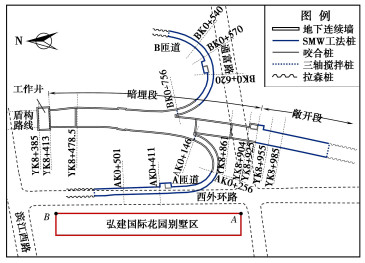
 下载:
下载:
